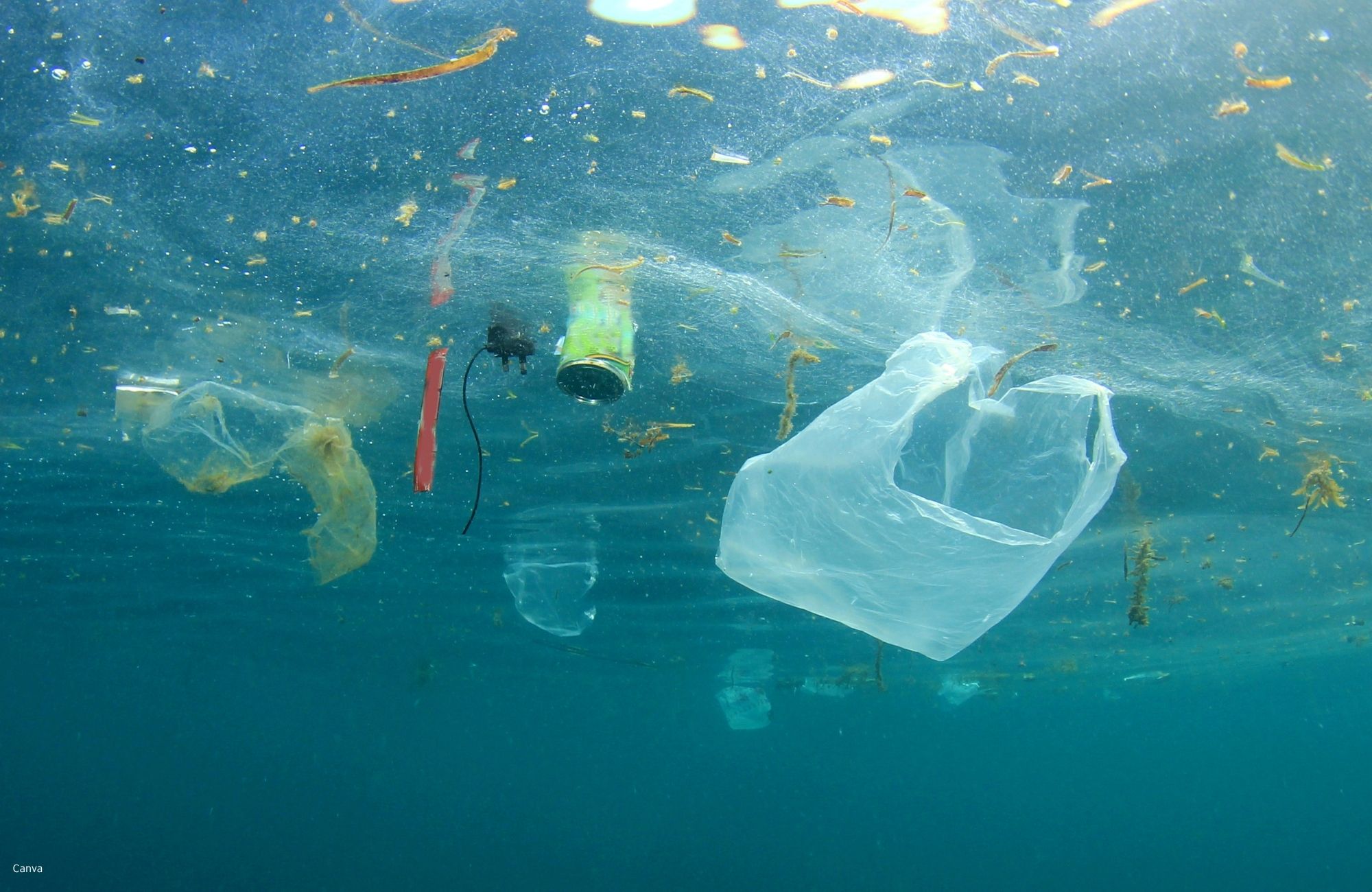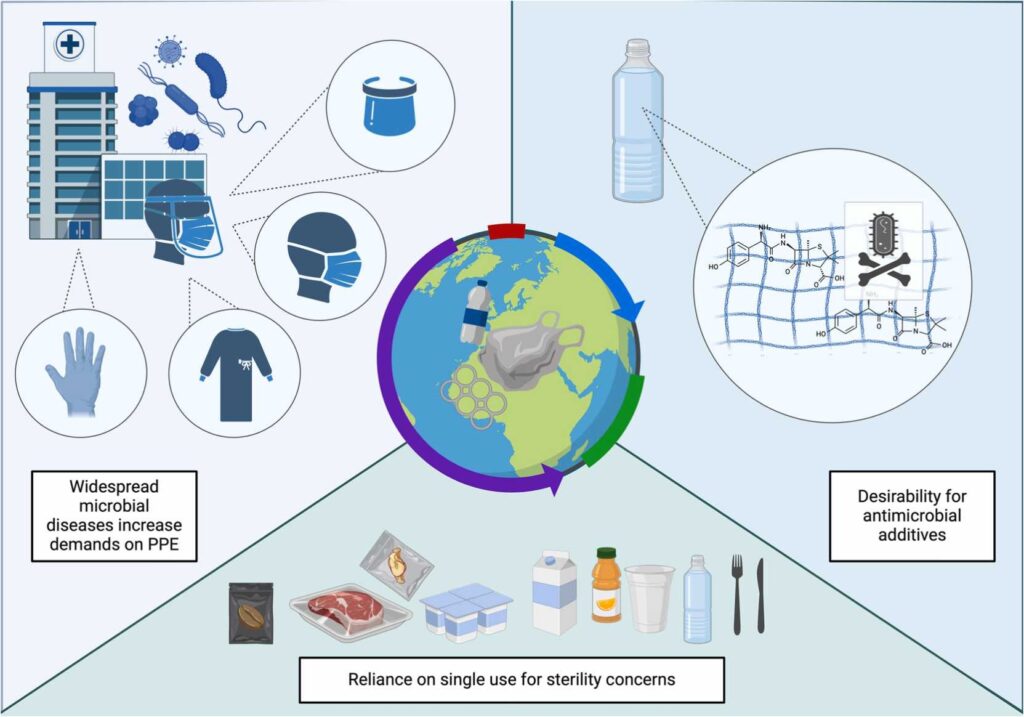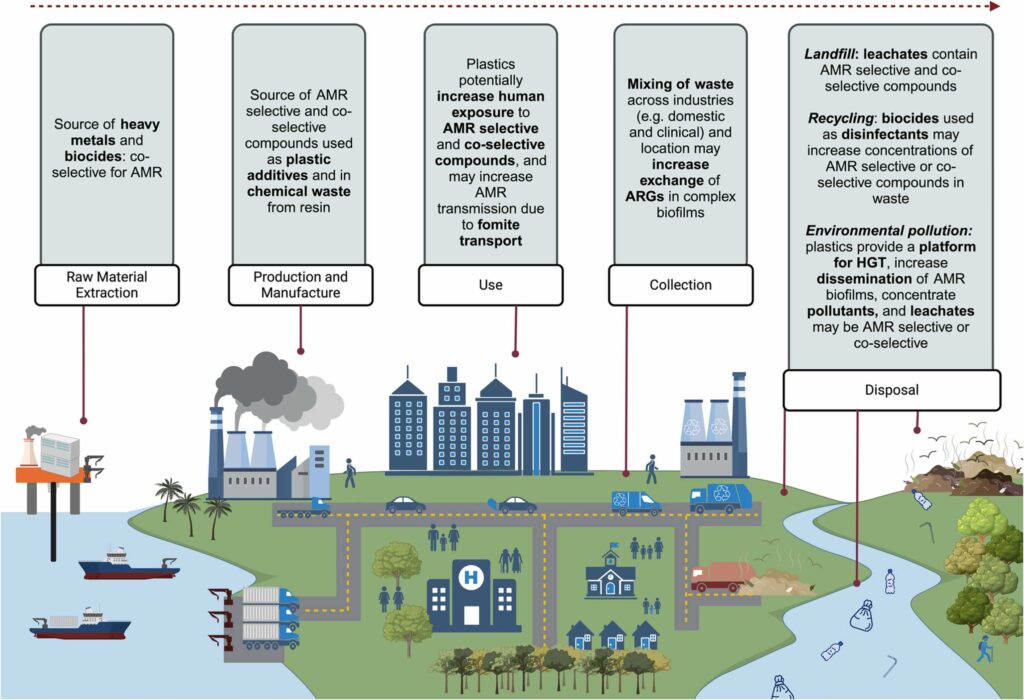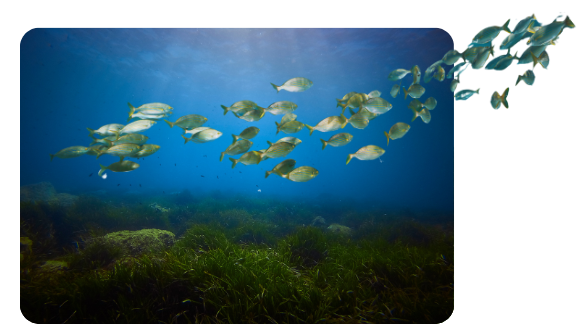Story
How plastic pollution may influence antimicrobial resistance
22 July 2025
New study reveals an alarming number of mechanisms throughout the life-cycle of plastic that could enhance or spread antimicrobial resistance.

Plastic pollution, antimicrobial resistance (AMR) and climate change are some of the greatest global challenges currently facing society and yet, research and mitigation efforts are often not joined up.
Vast quantities of plastics are produced and used each year, with an estimated 376 million metric tonnes of plastic produced globally in 2020, with almost a quarter of the world’s plastic waste being mismanaged or littered.
Owing to its durability, plastics will remain in the environment for centuries, posing a multitude of threats to humans, animals and global ecosystems.

AMR is one of the greatest threats to modern medicine. In 2019, there were an estimated 4.95 million deaths worldwide associated with bacterial AMR, with drug-resistant infections predicted to become the world’s primary cause of death by 2050, if left unchecked.
Historically, AMR has largely been considered a clinical, human health issue. However, the environment is now recognised as playing an important role in the emergence and spread of AMR microbes, and previous research has shown that plastic litter is likely contributing to this.
Now with the addition of climate change, for which there is a growing evidence base linking climate change and the emergence and evolution of AMR, it is crucial that research efforts gain a better understanding of the interplay between these issues.
Emily Stevenson, lead author and PhD researcher with the University of Exeter and Plymouth Marine Laboratory, said:
“By highlighting the interactions between plastics at different lifecycle stages and AMR under the umbrella of a changing climate, research and mitigation efforts may be more appropriately targeted, and solutions can be developed to address these issues in parallel, such as reformed governance, interconnected policy or joint monitoring frameworks”.
The comprehensive study explored the various touch-points between plastics at different lifecycle stages and AMR:

Raw material extraction
- Oil-based plastics are produced from petroleum products that start life as fossil fuels, including crude oil, natural gas and coal. The fossil fuels are often transported from their extraction site to refineries via biocide-treated pipes. Biocides, used to kill or control biological organisisms, have been widely documented for their ability to contribute to the development of AMR. It has also recently been proposed that the biocides used specifically for purging purposes may co-select for AMR, or in other words indirectly lead to increased resistance to other unrelated antimicrobial agents, when released into the environment during spills or within the pipes themselves.
- Crude oil spills have been found to increase AMR within environmental bacteria. In a recent study linking oil spillages, AMR and wildlife exposure, dolphins tested from an oil spill-impacted estuary had a greater prevalence of AMR and multi-drug resistance than those tested in control estuaries. This link between oil and AMR may be due to the high abundance of co-selective heavy metals and/or the presence of aromatic compounds in oil, which have also been found to support the development of AMR.
- There is concern that the intensive chemical processes involved in processing raw materials to make plastics may generate exhaust particles that could contribute to the evolution of AMR. A recent study found that diesel and petrol exhaust particles induced a concentration-dependent increase in the horizontal gene transfer of AMR genes in Escherichia coli.
Production and manufacture
- During the production stage of plastics intended for consumer markets, additives are often physically incorporated to enhance the desirable qualities of plastics, including plasticisers, fillers, UV stabilisers, flame retardants, anti-oxidants, colourants, and biocides. Typically, these additives are not chemically bonded to the plastic, increasing concerns of them leaching into the environment and there is a growing body of research on the role of plastic additives in driving the evolution of AMR.
- The recently published database ‘Chemicals Associated with Plastic Packaging’ lists 906 chemicals likely associated with plastic packaging, and a further 3377 substances that are possibly associated. Many of the chemicals were found to be hazardous to both human health and the environment according to the European Chemicals Agency. Included in these chemicals were known biocides, including triclosan, which may support the development of AMR through co-selection. The database also reveals that heavy metals used as additives in plastics and plastic packaging are responsible for co-selection of AMR, as well as their capacity to support co- or cross-resistance to many antibacterial agents.
- A recent study showed that exposure to polyvinyl chloride (PVC) plastic leachate enriched AMR genes and also increased infection-causing genes in a natural seawater community.
- Commonly-used plastic additives in drinks bottles and food storage containers, bisphenols, have also been highlighted to pose an AMR selection risk and promote transfer of a clinically important multidrug-resistant plasmid (bacterial DNA), supporting the hypothesis that exposure to these compounds may increase the spread of AMR in bacterial communities.
- Phthalates, primarily used to makes plastic more flexible, have been previously found to promote horizontal gene transfer of AMR genes in the environment. These phthalates reach the environment through industrial effluents, where they may pass through wastewater treatment plants and into surface waters or sediments. Here, environmental communities may be exposed to these contaminants, potentially increasing AMR in environmental bacterial reservoirs.
- Once crafted into raw polymers, plastics are sold in multiple formats, including pellets (nurdles) or resins. From this, they can be moulded into products, typically via extrusion or injection moulding, for consumer use. The production of resins generates large volumes of pressurised gases containing toxic emissions including heavy metals. Where heavy metals are emitted into the environment, they may be causing co-selection for AMR within environmental populations of microbes.
Use
- Increased human exposure to these chemicals could increase co-selection for AMR within the human body, for example, within the gut microbiome or upper respiratory tract. One potential route of exposure includes the traces of heavy metals that have been found to diffuse from plastic packaging into the food they contain. Studies suggest that hot foods can increase the concentrations of contaminants leaching from the polymer, and that metals diffuse at a greater rate from plastic containers into food than paper containers.
- Metalloid antimony, a compound frequently used as a flame retardant in consumer plastics but known to contribute to treatment failure as a result of AMR, can leach from recycled plastic bottles, reaching levels that exceed the US Environmental Protection Agency’s maximum contamination limit.
Collection
- Previous reports highlight several physical risks related to microbial infection faced by workers in the waste collection industry. If the collection of waste results in a higher incidence of exposure to infectious organisms, it may also result in the greater exposure to AMR microbes associated with plastics.
- Additional concern arises when wastes from various sources are collected together. If contaminated medical waste is combined with waste from other sources, this may present a route for the transport and transmission of AMR pathogens or genes of clinical origin, which may persist on the waste in the form of biofilms. If this does generate an exposure route to humans, methods to reduce exposure should be prioritised, including the use of personal protective equipment (PPE) and regular monitoring or routine testing of the workforces affected.
Disposal
- Landfill sites have been widely cited as a hotspot for AMR bacteria and resistant genes. Not only does this present a potential exposure route but it is also concerning for the surrounding environment. Landfill leachates may increase the occurrence of AMR in environments adjacent to waste sites, including soils, agricultural land and livestock, wastewater, groundwater, and in aerosols.
- Landfill sites are also known to accumulate emerging chemical contaminants, which can lead to the development of AMR in microorganisms, including antibiotics, heavy metals and personal care products.
- During periods of heavy rainfall, landfill contaminants can disperse into the surrounding environments, including soils and groundwater. This presents an ideal reservoir for environmental AMR bacteria, and a direct exposure route to the people relying on a healthy and safe environment for subsistence, agriculture, recreation and also for cultural, religious or social reasons.
- Recycling plastic products can result in the accumulation of hazardous chemicals in secondary materials. A study found that reprocessed plastics from household waste had the highest metal concentrations and suggested that the desire for higher recycling rates may lead to greater metal concentrations in recycled plastics in future. If these reprocessed plastics do concentrate heavy metals, they could leach from the plastic into the environment, increasing environmental concentrations of heavy metals and potentially, the AMR co-selection risk posed.
- Materials destined for recycling are also typically treated with washing agents, disinfectants or biocides prior to recycling. Residual contaminants can persist in waste effluents and may enter the environment, exposing microbial communities to these agents and therefore, support AMR co-selection.
- Microbial communities have been widely documented to colonise plastic waste in environment, known as the ‘Plastisphere’, and these communities have been found to be distinct to the surrounding microbial environment. The ‘Plastisphere’ has been suggested to serve as a pool of both pathogenic and AMR, which can be transported to novel or pristine environments, get ingested by wildlife or even increase human exposure when stranded on bathing beaches.
Prof. Pennie Lindeque, co-author on the paper and Head of Group for Marine Ecology and Society at Plymouth Marine Laboratory, added:
“AMR may also be an inadvertent driver of plastic production, use, and pollution. For example, the demand for single-use plastics to ensure sterility in clinics could increase plastic waste. Furthermore, microbial pandemics, like COVID-19, have increased single-use plastic PPE, with vast quantities of waste resulting from discarded masks and gloves”.
This study has highlighted several theoretical links between plastics and AMR that lack first-hand investigation, and identifies the following outstanding research questions in particular:
- Do biocides used to de-contaminate pipes in raw material (crude oil) extraction co-select for AMR?
- Is there an AMR selection risk posed by crude oil spills?
- What is the AMR selective potential of common plastic additives?
- Could the leaching of heavy metals from food-related plastic packaging present an exposure risk of the human gut microbiome to co-selecting compounds?
- What is the role of landfill sites as a source of AMR bacteria and ARGs?
Using these questions, studies should be conducted to validate the proposed mechanisms. Data from these studies may then be used to inform interdisciplinary efforts to develop sustainable plastic alternatives and large-scale monitoring programmes.
